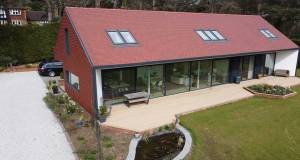
- Marketplace
- Posted
Don’t see MVHR as a heating or cooling system — CVC Direct
This article was originally published in issue 33 of Passive House Plus magazine. Want immediate access to all back issues and exclusive extra content? Click here to subscribe for as little as €10, or click here to receive the next issue free of charge
“A common call to the office every winter, is that the MVHR system is not providing enough heating. Another is in the summer stating that the MVHR system is not providing enough cooling. These are common misconceptions of an MVHR system,” CVC Direct’s Nicholas Vaisey told Passive House Plus.
“MVHR works by extracting warm moist air from ‘wet’ rooms and supplying filtered, warmed air to the bedrooms, living rooms etc. The extracted warm air is drawn through a ducting system, back to a main unit which contains a heat exchanger. At the same time fresh air is bought in from the atmosphere. The extracted air is used to warm the incoming fresh, filtered air. This fresh, filtered, warm air is then reintroduced back into the property via a ducting system.
“Our Brink MVHR units provide a heat recovery efficiency of up to 91%, and while this is highly efficient, there is still a minimal amount of heat loss — although considerably less than if using extract only ventilation and trickle vents in windows. Typically, when the extracted air is 21C and the outside temperature is 0C, the air that is supplied back into the building will be 19C. The MVHR unit itself does not provide any heating, it just recovers what is already there.”
Vaisey continued: “Summer bypass is designed for warmer periods, where fresh air can be bought into the property, whilst bypassing the heat exchanger. Since the air avoids the heat exchanger, it is not preheated by the extracted warm air. Solar gain in the summer months has the potential to provide a lot of heat in a property, especially when there are large expanses of glass. The cooling effect of the summer bypass is limited and often not enough to counteract the heat gains. The most effective methods to deal with solar gain are through shading and effective design of the building.”
“An MVHR system on its own does not provide cooling or heating, though there are elements that can be added to the system to provide these functions.”
Related items
-
 New Ejot profile cuts thermal bridging losses by 25mm insulation equivalent
New Ejot profile cuts thermal bridging losses by 25mm insulation equivalent -
 Build Homes Better updates Isoquick certification to tackle brick support challenge
Build Homes Better updates Isoquick certification to tackle brick support challenge -
 Ecological Building Systems expands UK and Irish straw panel construction with EcoCocon deal
Ecological Building Systems expands UK and Irish straw panel construction with EcoCocon deal -
 Focus on better buildings, not better spreadsheets
Focus on better buildings, not better spreadsheets -
 MBC offers total passive house envelope solutions
MBC offers total passive house envelope solutions -
 Historic Dublin building retrofitted with cutting edge insulation
Historic Dublin building retrofitted with cutting edge insulation


